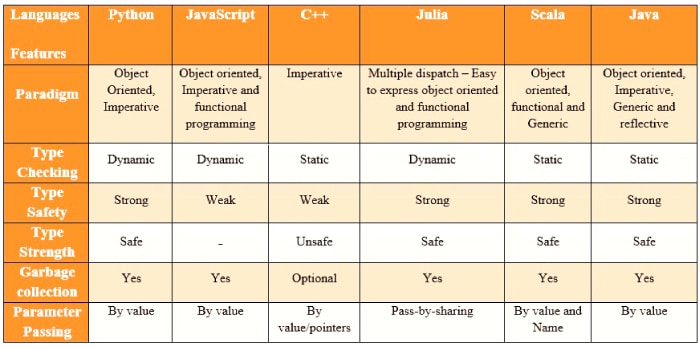There are a number of open source programming languages available that can be used to create powerful artificial intelligence based solutions. If you are interested in a career in programming you need to be aware of these languages and how to select between them. This article analyses the major programming languages and open source frameworks for AI and ML, and also identifies those that are best suited for artificial intelligence development.
Open source programming languages have become an important part of the development of artificial intelligence (AI) and machine learning (ML). These languages enable developers to access a wide range of open source libraries and frameworks that can be used to create powerful AI and ML based solutions. AI is an important part of many software development projects as it allows developers to create software that can observe, acquire, goal and solve problems — much in the way a human mind operates. Learning how to apply artificial intelligence is critical for many job roles, especially for those interested in pursuing a career in programming. Choosing the right language can help you get a leg up in this quickly growing field, but many people struggle with where to begin. Getting a start now can help you ride the waves of change into the future.
Creating an AI system
AI implementation has made it possible to introduce tools and solve problems in new and complex ways. However, it’s not an all-inclusive solution to every programming challenge out there — making a program that utilises AI requires careful thought and planning.
The first thing to consider when building an AI system is the problem. Ask yourself: What am I going to solve? And what is the expected outcome of the solution? Your answers to these questions can drive you towards different AI-focused solutions, like machine learning (ML) for data processing or using computer vision (CV) to derive meaningful information from digital images and videos.
The next step is to consider the amount of data and type of data that you’re processing using AI. Artificial intelligence algorithms are powerful, but they’re not magical. If poor-quality data is fed into the system, it’s unlikely to produce the desired results. Be sure your data has been checked, cleaned and organised according to specified requirements.
AI is a broad field with many wide applications. The best option for you will depend on the specifics of your project, as different programming languages excel at various AI-related tasks. Choosing the appropriate programming language depends on what you need to accomplish within a specific application.
The following steps are recommended.
- Gather data: The first step to creating artificial intelligence is to gather relevant data. This data should be specific to the problem you are trying to solve, and should include as much information as possible about it.
- Pre-process data: Once you have your data, you will need to clean it up and pre-process it. This includes normalising the data, removing noise and irrelevant information, and formatting it in a way that makes it ready for analysis.
- Analyse data: Next, you’ll need to analyse the data to identify patterns, trends, correlations, and other insights. Depending on the type of data you’re working with, you might use statistical methods, machine learning algorithms, or other methods to gain insights into the data.
- Build a model: Once you’ve analysed the data, it’s time to build your AI model. Here, you’ll need to choose the right algorithm, define the parameters of your model, and train it on your data.
- Test and evaluate: Finally, you’ll need to test and evaluate your AI model. This will help you determine how accurate and reliable it is, and help you identify any areas that need to be improved.
Programming languages for AI/MLPython
Python is the most popular programming language for AI. It’s one of the hottest languages going around, and is also easy to learn.
Key features: Python features include its easy-to-read syntax, wide range of application areas, and powerful libraries, such as NumPy, SciPy, and Pandas. Python also offers object-oriented programming, functional programming, and procedural programming paradigms, making it a versatile and powerful language.
What makes Python good for AI: Python is a great language for AI development because of its readability and flexibility. It has a wide variety of libraries and frameworks for AI and machine learning, such as scikit-learn, TensorFlow, and Keras. Python also makes it easy to develop prototypes and explore different approaches to AI problems. Its syntax is easy to read and understand, which makes it well suited for AI development.
JavaScript
JavaScript is a popular language for web development. Developers use JavaScript in machine learning libraries like TensorFlow.js. It has multiple high-level tools and libraries for machine learning.
Key features: JavaScript can be used in AI applications in a variety of ways. It can be used to create user interfaces for AI applications, build neural networks, create machine learning models, process data, and create bots and automated systems. JavaScript can also be used to build web apps that interface with AI systems, and to create visualisations of AI data.
What makes JavaScript good for AI: JavaScript is a scripting language that enables developers to create complex applications quickly and efficiently. It has a wide variety of features that make it well-suited for AI development, such as its ability to easily integrate with other technologies, its vast selection of libraries, and its machine learning capabilities. With JavaScript, developers can create powerful AI applications with a low learning curve, making it an excellent choice for AI development.
C++
Many machine learning and deep learning libraries are written in C++. Notable C++ libraries include Shark, which supports supervised learning algorithms like linear regression, and mlpack, which offers extensible algorithms that users can integrate into scalable ML solutions.
Key features: C++ is a great choice for high-performance applications, graphics-centric apps, games, embedded devices, and faster calculations. It ranks among the most popular programming languages after Python, C, and Java. TensorFlow, Caffe, Microsoft Cognitive Toolkit (CNTK), mlpack Library, DyNet, FANN, OpenNN, and Shogun are several popular AI-ML libraries for C++.
What makes C++ good for AI: C++ is a great language for AI development because of its speed and scalability. It is a high-level, strongly typed language, which makes it easy for developers to write complex algorithms quickly and effectively. It also offers a large library of tools and libraries that can be used to create powerful AI applications. Its object-oriented nature allows for easy maintainability, and its portability allows an AI system to be developed on multiple platforms.
Julia
Julia was designed for high-performance numerical computing and has solid support for machine learning. Julia can be integrated with TensorFlow.jl, MLBase.jl, and MXNet.jl.
Key features
High performance: Julia is a fast and powerful programming language designed for high-performance numerical and scientific computing. It is designed to outperform existing languages such as Python, Matlab, and R in terms of speed, and its LLVM-based compiler infrastructure enables it to achieve this.
Easy to learn: Julia has a simple yet powerful syntax, which makes it easy for beginners to get started with the language. It also has a comprehensive documentation system which makes it easy to learn it quickly.
Dynamic typing: Julia supports dynamic typing, which allows for rapid prototyping and debugging. This feature makes it easier to work with data, since you don’t have to define types for every variable and can easily change the types of variables as needed.
Multiple dispatch: Julia’s multiple dispatch feature allows functions to be specialised for different argument types. This makes it easier to write code that is both concise and efficient.
Parallelism: Julia’s parallelism capabilities make it easier to write code that can take advantage of multi-core or distributed architectures. This allows for large-scale problems to be solved faster.
Packages: Julia has a large number of packages available, which makes it easier to find libraries and frameworks that can be used in your projects. It also has a package manager, which makes it easy to install and update packages.
What makes Julia good for AI: Julia is well-suited for AI because it is a high-performance, dynamically-typed language that allows for fast development and iteration. It also has a wide range of libraries and packages that make it easy to add AI capabilities to your applications.
Julia’s parallel computing capabilities allow for more efficient processing of large data sets, which is important for many AI tasks. Additionally, Julia’s syntax is easy to learn and understand, making it accessible to people of all skill levels.
Scala
Scala is significantly faster than Python, and brings the best of object-oriented and functional programming to one high-level language. It was originally built for the Java virtual machine (JVM) and easily interacts with Java code. Developers can build high-performance systems easily, while avoiding bugs through Scala’s use of static types.
Key features
Scalable: Scala is highly scalable and supports high-performance computing, making it ideal for developing AI applications.
Concise: Scala has a concise syntax, making it easy to read and write code.
Platform independent: It is platform independent, so it can be used on any platform.
Functional programming capabilities: Scala supports functional programming, which is essential for developing AI applications.
Multi-paradigm language: Scala supports multiple programming paradigms, including object-oriented and functional programming, making it suitable for AI development.
What makes Scala good for AI: Scala is a great choice for AI development due to its scalability, concurrency, and performance. Its support for functional programming simplifies the development of complex AI algorithms. Its type system makes it easier to avoid errors when coding AI applications. Additionally, Scala’s interoperability with Java enables developers to take advantage of existing Java libraries and frameworks when creating AI applications.
Java
Java is an incredibly powerful language used across many software development contexts. It’s especially prevalent in the mobile app space, where many applications are taking advantage of its artificial intelligence features.
Key features: Java is a great language for AI because of its flexibility, scalability, and platform independence. It is an object-oriented language that allows for easy modularity and code reuse.
What makes Java good for AI: Java also has a large library of available packages for AI development, making it easy to find existing solutions to AI problems. Additionally, Java is well-supported and has a thriving community of developers, making it easier to find help and resources.
Open source AI frameworks
Open source AI frameworks are software frameworks that are designed to provide a foundation for developing artificial intelligence applications. They allow developers to create intelligent applications without having to write complex code from scratch. Open source AI frameworks provide a wide variety of tools and libraries that make it easy to build AI applications.
Some of the popular open source AI frameworks are TensorFlow, Caffe, Theano, Torch, and scikit-learn. These frameworks provide developers with a wide range of features such as machine learning algorithms, neural network architectures, optimisation techniques, and data-processing capabilities. They also provide access to powerful computing resources such as GPUs, TPUs, and distributed computing clusters.
These frameworks are widely used by researchers and developers to develop, test, and deploy AI applications. They enable developers to quickly create prototypes, debug code, and deploy applications in production.
Tensorflow
TensorFlow is a free and open source software library for dataflow and differentiable programming across a range of tasks. It is a symbolic maths library used for machine learning applications such as neural networks. It is used for both research and production at Google. It is based on dataflow graphs, where nodes represent mathematical operations and edges represent the data that flows between them. The flexible architecture allows for the easy deployment of computations across a variety of platforms (CPUs, GPUs, TPUs), as well as from desktops and clusters of servers, to mobile and edge devices.
PyTorch
PyTorch is an open source machine learning library for Python, used for building and training neural networks. It is based on the Torch library, and provides a wide range of features for deep learning and optimisation. PyTorch also provides a variety of tools and libraries for computer vision, natural language processing and reinforcement learning. In addition, it offers a distributed training framework and an efficient data loading system. It is designed to be easy to use, scalable, and extensible.
The road ahead
Programming languages are becoming increasingly more sophisticated and are providing more comprehensive support for AI development. The most popular programming languages for AI development are Python, Java, and C++. Python is the most popular programming language for AI development because of its ease of use and its comprehensive library of AI tools. Java is also widely used for AI development because of its robust object-oriented programming capabilities. C++ is a good choice for AI development because of its powerful capabilities for handling complex algorithms and data structures.

Programming languages will continue to evolve to better support AI development. More advanced AI libraries and frameworks will be developed that make it easier to create AI-driven applications. AI-specific programming languages such as Prolog and Lisp will also gain more traction. Additionally, as AI algorithms become more sophisticated, more robust programming languages will be needed to handle these complex algorithms and data structures.




